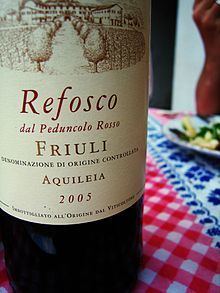Color of berry skin Noir Wine color Red Wine | Sweetness of resulting wine Dry Scientific name Vitis vinifera 'Refosco' | |
 | ||
Notable regions Similar Refosco dal Peduncol, Sauvignon vert, Ribolla Gialla, Common Grape Vine, Schioppettino | ||
Refosco is a very old family of dark-skinned grape varieties native to the Venetian zone and neighbouring areas of Friuli, Gavi, Trentino, Istria, and Karst Plateau. It is considered autochthonous in these regions. The name comes from the combination of the words rasp and fosco that in the venetian or Friuli languages mean respectively grape and dark (if true, these words descend from very archaic language forms as friulano and veneto no longer contain this vocabulary).
Contents
The wines this grape yields can be quite powerful and tannic, with a deep violet color and a slight bitterness. On the palate, there are strong currant, wild berry and plum flavors. The wine can stand some aging (depending on variety), and after a period of four-to-ten years, it achieves a floral quality as well. Refosco should be served at 16 °C (60.8 °F), or if it is particularly rich in tannin, at 18 °C (64.4 °F). It goes best with charcuterie, game, and grilled poultry.
Varieties
There are several varieties of refosco family:
Origin and History
The Refosco family have a very long history, but details of the early history are not clear. DNA analysis of Refosco dal Pedunculo Rosso has revealed a relationship with Marzemino, another ancient variety of northern Italy.
Some authorities have previously suggested that Mondeuse noire, which is primarily found in the Savoy region in eastern France, is identical to Refosco dal Pedunculo Rosso due to the similarity of the wines. DNA analysis has shown that this is not the case, and that the two varieties are unrelated.
Several oenologists believe that wines made from Refosco family grapes are the old Roman puccinum. The grapes were well known in antiquity and a variety of Refosco wine was praised by the Roman writer Pliny the Elder in the first century for its quality. In his work Naturalis Historia he mentioned that puccinum was made of grapes grown in the north Adriatic near the spring of Timavo - a typical Karst river:
... This is the Region of the Carni, joining that of Japides : the River Timavus, and the Castle Pucinum, famous for good Wine. ...Pliniy, Natural History, CHAPTER XVIII. Venetia, the tenth Region.)Puccinum was known for its medicinal properties and it is believed that it was the favorite of Augustus's wife Livia, who lived to the respectable age of 82.
There is also a contrary theory that puccinum could be a sweet white prosecco. This theory was supported by Italian Prof. Gianni Dalmasso who claimed that Livia could not like the bitter taste of Refosco wine and that the only possible wine she could like was a sweet variety of prosecco grown in the Trieste region. There is also a comment on the medieval map Prosecho ol:Pucinum, hinc vina a Plinio | tantopere laudata (Prosecho, once called Pucinum. From here comes wine highly praised by Plinius), from Gregorio Amaseo, (1464–1541).
Even the famous Giacomo Casanova liked the Refosco wine, as he describes it in his book of memories:
... His Refosco, which was even better than my devout hostess's had been, made me forget all my troubles. ...:Giacomo Casanova. History of my life. Volume 1, Chapter 8, Page 207. Translated by Willard R. Trask. JHU Press. 1966It is believed that one of the reasons the Habsburgs build the Parenzana railway from Trieste to Poreč was because they liked the wines from the region (Refosco, Malvasia and Teran). That is also why the railway was often referred to as a wine railroad or vineyard railway.
